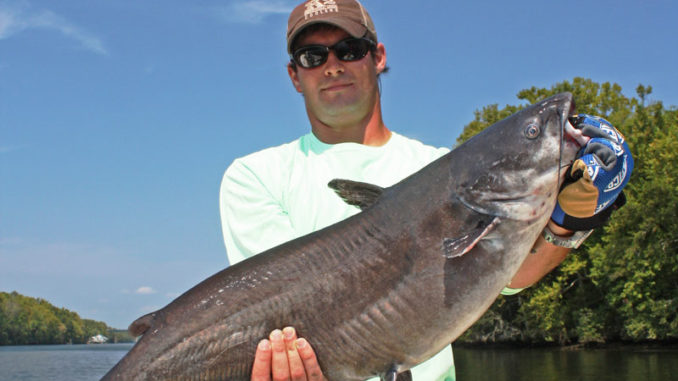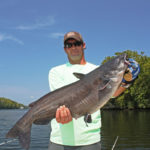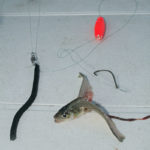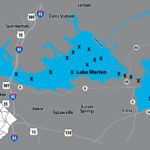
A variety of baits, fished with a variety of techniques, will catch a variety of Santee Cooper catafish.
Catfishing on the Santee Cooper lakes has morphed into a year-round quest, but summer is tops for as providing the year’s most-diverse catfishing opportunities. Fishing is literally three-dimensional, with blue, channel and flathead catfish all on a great bite. Fishermen can fish shallow or deep, day or night, in either lake or the Diversion Canal, and catch big numbers of cats or big cats.
Depending on the location and species targeted, big live bait, cut bait, stinkbaits, night crawlers, catalpa worms and even shrimp will all produce plenty of catfish. If you can’t find your niche with these diverse choices, go back to bass fishing.
Lake Moultrie is on fire for big catfish during the summer, and not just because of the heat. Huge cats are taken around the clock, and drift-fishing is the most popular tactic in July and into August.
Guide Doug Allen of Bonneau targets big catfish on Lake Moultrie, focusing on the lower lake because the open water is ideal for drift-fishing.
“During July and August, I drift-fish late evening and at night, usually fishing from about 4 o’clock until midnight; both day- and night-fishing can be productive,” Allen said. “I catch more and bigger cats at dusk and after dark, and it’s a lot more comfortable time to fish.”
Allen said a big factor in his success is that he doesn’t pre-determine any specific depth as a pattern until he fishes.
“At this time of year, I begin fishing the previously productive depth patterns, but in reality, it changes from day to day; the key is to go fishing and find them,” he said. “I’ll usually start in the 15- to 30-foot depth range, but I will work deep water, too, over 40 feet. I almost always make at least one drift, usually near the end of a trip, in shallow water at night. I’ll usually get into water perhaps 4 feet and drift back out deeper.
“There have been many occasions when we caught 40-pound plus fish in that shallow water around midnight, but we’ve also usually caught big fish in the deeper water the same trip. Catfish are found in a variety of depths, and that’s why drift fishing works best for me. When someone asks how deep the fish are in the summer, I reply by saying they’re either deep, shallow or somewhere in between. I go fishing and figure it out.”
Allen uses a standard drift rig with 30-pound test main line, a leader of 50-pound test with 5/0 and 7/0 circle hooks, depending on the size of bait. He said he’ll use big baits as well as small baits, and he’ll catch plenty of big fish on both this month.
“My favorite baits are white perch and bream, with herring and shad also begin productive,” Allen said. “I like to use the head part of the bait; it’s best when cut on a 45-degree angle to allow more scent into the water. I believe if I pull that bait by a big blue, we’ll get bit. I do change baits to ensure the scent is still a factor.
“Even though I drift-fish, it is not random,” he said. “I target specific underwater areas because of the changes in the bottom. I like to fish old road beds, ledges, humps and around the sides of islands near deep water. When fishing the shallows, I like a situation where a shallow flat drops into deep water. The fish may be shallow but won’t usually be far from the deep water. Drifting over changing depths helps me target the fish pattern on given days — or at least for a few hours.”
Opportunities for both big blues and huge flatheads exist on the lower end of Lake Marion, according to guide Alan Spence, who said fishing from late afternoon until midnight gives him the best opportunity to catch big catfish.
“With the bright sun, the catfish tend to be deep and less active during the bright, daylight hours in Lake Marion,” he said. “But late evening and up until midnight, the big fish will typically feed more aggressively. Fishing the last few hours of day and for a few hours after dark gives me the best opportunity to get into catfish, especially big blues and flatheads.”
Spence said two different patterns emerge in July.
“One pattern either day or night is to drift-fish,” he said. “There are some large areas in the lower end of the lake in the standing trees where I can effectively drift as well as other open areas where the bottom debris will allow effective drifting. A lot of my fishing before dark will be around 26 feet or deeper, and shallower after dark.
“Another tactic is to anchor and fan-cast with up to 12 rods out,” he said. “I target specific places for anchoring. I use the graph to check areas along drops, ledges, humps and channels, and when I see forage fish along with big marks that I believe to be catfish, I’ll set up. Sometimes I’ll anchor in 10 feet of water and will catch huge flatheads and blues near the shoreline in skinny water. I like whole live herring or gizzard shad, and both flatheads and blues will take a big live herring or shad.”
Fishing is also very good in the upper end of Lake Marion, according to Steve Pack at Packs Landing.
Pack will catch catfish on a very productive pattern somewhat unique to the upper end of Lake Marion.
“The freshwater mussels begin to die off and start floating to the surface, and the blue catfish in particular will begin to feed heavily on them,” he said. “I’ll drift fish in the open flats, such as the Elliot’s Flats downlake from the railroad trestle. If it’s windy, we’ll catch big catfish as shallow as 2 or 3 feet deep in 7 to 8 feet of water drift-fishing shad or herring. The rigs are the key. We’ll use a crappie-sized float, about 2 ½ inches long, and a No. 3 split-shot with the bait suspended about 2 to 3 feet down.
“The catfish will be roaming the flats looking for the mussels and will readily take the cut bait. I’ll get into some huge catfish in this unique manner every summer. The water depths and forage are such that the depths we have in this part of the lake are ideal for this fishing and with big catfish and shallow water, it makes for some exciting fishing. We do most of our fishing during the day, with the first few hours and late afternoon the favored times because of the heat.”
Pack said this pattern will usually last several weeks, often beginning in June and going through July. On calm days, he said catfish may be found a little deeper, so he’ll drift or use an electric motor to work deeper areas.
“I’ll still be fishing relatively shallow, usually 6 to 8 feet deep in 10 to 12 feet of water,” he said.
One other area that produces lots of numbers and hefty catfish is the Diversion Canal.
Jamie Courtney at Hills Landing, which is on the Canal, said July produces some of the very best fishing of the year in that area.
“Water flowing though the Canal is the key,” Courtney said. “The current attracts catfish like crazy during hot weather.”
Courtney said fishing can be excellent both day and night, but the techniques are different.
“Drift-fishing, specifically bouncing the bait on the bottom, is the best tactic,” Courtney said. “I’ve found the best way is to have a 3-way swivel and a weight on the bottom heavy enough to keep the line fairly straight and vertical so I can feel the bite and bump the bottom without snagging as often. The size of the weight will vary with the depth and current flow but is usually 2 to 3 ounces. The swivel should be about 18 inches up the line, and a 12-inch leader with hook attached there. Keep the line straight under the boat and just off the bottom as you drift down the Canal. Fish the center as well as along the base of the drop.”
Courtney said the best baits will vary, but stinkbaits are lethal for both channel and blue catfish.
“The stinkbaits produce extremely well, especially on numbers of fish,” he said. “Plenty of 30-pound and larger blue catfish are caught on stinkbaits. A lot of channel catfish and smaller blues are also caught on stinkbaits, but the best way to target a big flathead or blue is to use whole live or fresh cut shad and herring.”
Courtney said fishermen prefer to anchor and flatline fish the bottom at night.
“Fishermen have to use their running lights so they can be visible, but they don’t use underwater lights to attract catfish,” he said. “The same baits work well at night, and that’s a great time to catch some big fish aggressively feeding. Often, it doesn’t take long to catch a huge cooler of mixed species of catfish at this time of the year, whether fishing by day or night.”
Courtney said anglers can fish shallower at night, in the 10- to 25-foot range, when anchored near deeper water along a ledge or hole.
DESTINATION INFORMATION
HOW TO GET THERE — The Santee Cooper lakes are easy to access from most places in South Carolina. Manning is a prime destination on the north side of Lake Marion, via SC 261 from I-95 at Exit 119. The town of Santee is on the south side of the lake, at Exit 98 off I-95. SC 6 will take you to the Diversion Canal and Lake Moultrie. Moncks Corner and Bonneau offer excellent access to Lake Moultrie. For a complete list of public ramps, visit www.scgreatoutdoors.com/hb-lakes.html.
WHEN TO GO — July is a great months for both quantity and quality of catfish on the Santee Cooper lakes, as well as in the rivers above and below the lakes. This is an excellent time of the year to catch really big blue and flathead catfish and huge numbers of hefty channel catfish.
BEST TECHNIQUES — Options for targeting catfish in July include drift-fishing Lake Moultrie, drift- or anchor-fishing Lake Marion and drift- or anchor-fishing the Diversion Canal connecting the two lakes. All areas are good day or night. Also, the rivers upstream and downstream of the lakes are outstanding during hot weather. Doc’s Catfish Dip Bait is awesome on all these areas for channel and blue catfish. The good news is the problem would trying to find a time or place you can’t catch catfish at Santee Cooper during July.
FISHING INFO/GUIDES — Doug Allen, 843-825-6237; Alan Spence, Spence’s Guide Service, 803-478-5029; Jamie Courtney, Hill’s Landing, 843-753-2731; Andy Pack, Steve Pack, Packs Landing, 803-452-5541; Chris Orvin, Overdose Fishing Charters, 843-509-2306. See also Guides and Charters in Classifieds.
ACCOMMODATIONS — Santee Cooper Counties Promotion Commission, 803-854-2131, www.santeecoopercountry.org; SC Association of Visitors Bureaus, www.discoversouthcarolina.com.
MAPS — Navionics Electronic Charts, www.navionics.com; Delorme’s South Carolina Atlas & Gazetteer, 800-561-5105, www.delorme.com; Kingfisher Map, 800-326-0257, www.kfmaps.com.








Be the first to comment